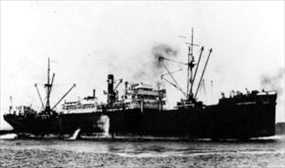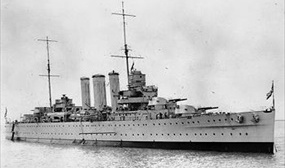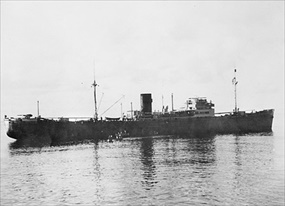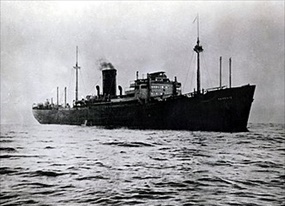GERMANS SINK FIRST U.S. SHIP IN WORLD WAR II
Melbourne, Australia • November 8, 1940
The war between the Allies and the German Kriegsmarine (Navy) is well known. Indeed, the Battle of the Atlantic (1939–1945) was the longest-fought battle of World War II. It primarily involved Allied and neutral merchantmen, typically under armed escort, carrying food, oil products, iron ore, steel, weapons, and other wartime essentials between North America and the Caribbean and their European destination, the British Isles and/or the Soviet Union. A troika of German U‑boats, aircraft, and commerce raiders sank over 3,500 merchant, passenger, and troop ships and 175 Allied warships. Germans called their commerce or merchant raiders “auxiliary cruisers” (German, Hilfskreuzer or Handels-Stoer-Kreuzer, HSK). Armed with 5.9‑inch/200‑mm cannons along with many lesser-caliber guns, these ocean raiders usually approached their targets under false flags and fake paint schemes. Smaller guns were hidden behind specially designed and hinged bulwarks or under fake deckhouses. Ofttimes ship silhouettes were altered with fake funnels and masts. Raiders engaged their victims at point-blank range. Some were equipped with torpedoes or observation seaplanes or both. Sometimes a single raider laid minefields or was joined by a captured merchantman converted into an auxiliary minelayer.
The transatlantic battle had its counterpart in the Indian and Pacific ocean theaters with fewer commerce raiders (there were 5) but just as many victims of sinkings by guns, torpedoes, and mines, although all without the assistance of U‑boats and wolfpacks. The modern 7,766‑ton Pinguin (Penguin), Nazi Germany’s most successful commerce raider, sank (16), captured (16), and damaged (1) a total of 33 vessels. Skippered by 42‑year-old Captain Ernst-Felix Krueder, Pinguin terrorized West Indian waters before capturing the Norwegian tanker Storstad on October 7, 1940, carrying 12,500 tons of diesel and fuel oil from British North Borneo to the Australian port city of Melbourne, Victoria’s capital and the state’s largest city. Krueder converted his prize into an auxiliary minelayer and renamed it Passat.
Steaming south along Australia’s east coast, Pinguin mined the approaches to Newcastle and Sydney in New South Wales on October 28, 1940, steamed further south to mine the approaches to Tasmania’s capital Hobart and South Australia’s capital Adelaide. The Passat meanwhile mined the Banks Strait off Tasmania’s northeast coast and the Bass Strait separating Tasmania and Victoria. In German minds a minefield in the narrow Bass Strait was attractive because, as a busy international shipping lane, it would maximize the destructive potential of the minefield and crimp Australia’s exports of raw and finished materials and foodstuffs that supported the Allied war effort. Sure enough, on the day Passat finished laying 110 high-explosive mines, one of them sank the British refrigerated cargo ship SS Cambridge off Victoria’s Wilsons Promontory at the eastern approach to Bass Strait.
Late the next day, November 8, 1940, the 20‑year-old American freighter SS City of Rayville fell victim to another of Passat’s mines, this off Victoria’s Cape Otway at the western end of the strait. Excluding the American gunboat USS Panay, sent to the bottom of the Yangtze River by Japanese aircraft on December 12, 1937, City of Rayville was the first American vessel sunk during World War II. (For some people Panay’s demise marks the outbreak of the Second World War, first in Asia in 1937, then in Europe in 1939.)
Moving south into Antarctic waters in December and January 1941, Krueder’s Pinguin seized the bulk of Norway’s whaling fleet (under British charter) in a bloodless maneuver before reentering the Atlantic and Indian oceans. It was in the Indian Ocean that fate caught up with Krueder and 531 other persons aboard his warship, among them some 200 captives. Intercepted by British heavy cruiser HMS Cornwall on May 8, 1941, the cruiser’s fourth salvo detonated all of Pinguin’s 130 mines. Pinguin was literally gone in a flash.
Saga of German Commerce Raiders in the Indian and Pacific Oceans During Second World War
 |  |
Left: The 5,883‑ton, 402‑foot/123‑meter steamship SS (or MV or MS) City of Rayville struck 1 of 110 German naval mines strategically planted in broad daylight over a 3‑day period in Australia’s heavily trafficked Bass Strait south of the port city of Melbourne. The minelayer was a converted Norwegian tanker renamed Passat after its capture. The west-bound City of Rayville, carrying 37,520 lead bars (1,500 tons) it had picked up at Port Pirie north of Adelaide, South Australia, was off Victoria’s Cape Otway when the incident happened close to 8 p.m. on November 8, 1940. Shrapnel and lead ingots sent upwards by the explosion rained down on the superstructure of the unwary prey as 38 crewmembers scrambled into lifeboats. Thirty-five minutes later the steamer disappeared below the water’s surface, becoming the first American vessel sunk by the Germans in World War II. Three boats from the village of Apollo Bay 11 miles/18 kilometers north of the Cape Otway lighthouse competed against darkness, rain, and heavy swells to find 37 survivors and tow their lifeboats to safety.
![]()
Right: An amphibious reconnaissance aircraft from British heavy cruiser HMS Cornwall located the notorious German commerce raider Pinguin (Raider F to the British) in the Indian Ocean flying the Norwegian ensign and bearing the false name Tamerlane on both sides of its bridge. The 27‑minute single-ship action occurred off the Seychelles archipelago north of Madagascar Island. Shells from both the “Norwegian” and British ships pounded each other. The second shell in a 4‑gun salvo from Cormwall’s forward 8‑inch/200‑mm turret gun shattered the bridge of the disguised Pinguin, instantly killing Captain Ernst-Felix Krueder. Cormwall’s fourth shell in the salvo landed in the German raider’s ammunition storage compartment, igniting 130 high-explosive sea mines which broke the ship in two. Of Pinquin’s 401 crewmembers, 323 died in the shelling, or the fiery explosion, or by drowning. Sixty enemy crewmen were rescued along with 22 of 222 British and Indian merchant sailors who had been snatched from over 30 vessels Pinquin had sunk or captured in its 10½‑month commerce-raiding career. A seaman from Cornwall was the single British casualty.
 |  |
Left: Pinguin in the Indian Ocean in 1941. Known to the Kriegsmarine as Schiff 33 and designated HSK 5, Pinguin was the most successful commerce raider of World War II. Formerly the freighter Kandelfels built in 1936, she was converted to an auxiliary cruiser (German, Hilfskreuzer) and was in the first wave of commerce raiders sent out by the Kriegsmarine, sailing on June 15, 1940, under the command of Fregattenkapitaen (Commodore), later Kapitaen zur See (Captain) Ernst-Felix Krueder. Pinguin remained at sea for 357 days and sailed over 59,000 miles/51,270 nautical miles, more than twice the circumference of the Earth. She sank or captured 28 ships (18 Norwegian and 10 British) for a total of 136,642 gross register tons. Some 52,000 tons were sent back to Germany or occupied Europe under prize crews. A further 4 ships (18,068 tons) were sunk by her mines. Pinguin’s grand total amounted to 154,710 gross register tons. Pinguin was the first of the Kriegsmarine’s commerce raiders to be sunk, thanks to the British heavy cruiser HMS Cornwall, which dispatched the aggressive predator on May 8, 1941, in the West Indian Ocean.
![]()
Right: Atlantis disguised as the Norwegian cargo ship Tamesis, 1940. Known to the Kriegsmarine as Schiff 16 and designated HSK 2. Formerly the German freighter Goldenfels, Atlantis was built in 1936 and converted to an auxiliary cruiser in 1939. Atlantis traveled a record 100,000-plus miles/86,898 nautical miles in 602 days under Kapitaen zur See Bernhard Rogge (1899–1982). Rogge conducted extensive operations in the South Atlantic and Indian oceans before entering the Pacific in September 1941. In the seas around New Zealand and French Polynesia Atlantis found few pickings (actually just one) before returning to the South Atlantic for a scheduled rendezvous with a German U‑boat north of Ascension Island. The Kriegsmarine’s instructions were intercepted and decrypted by Bletchley Park code breakers. British heavy cruiser HMS Devonshire was thus dispatched to the rendezvous point. When Atlantis, posing as the Dutch ship Polyphemus, came into view on November 22, 1941, Devonshire loosed 3 salvos, wounding the pirate ship and setting off its munitions. Before slipping under the waves, Rogge’s Atlantis could boast of sinking or capturing 22 ships for a combined tonnage of 144,384, taking second place behind Pinguin’s 32 ships. A 1960 Hollywood version, Under Ten Flags, tells the Atlantis story from the German viewpoint.
German Commerce Raiders: Aggressive Predators in World War II
![]()

 History buffs, there is good news! The Daily Chronicles of World War II is now available as an ebook for $4.99 on Amazon.com. Containing a year’s worth of dated entries from this website, the ebook brings the story of this tumultuous era to life in a compelling, authoritative, and succinct manner. Featuring inventive navigation aids, the ebook enables readers to instantly move forward or backward by month and date to different dated entries. Simple and elegant! Click
History buffs, there is good news! The Daily Chronicles of World War II is now available as an ebook for $4.99 on Amazon.com. Containing a year’s worth of dated entries from this website, the ebook brings the story of this tumultuous era to life in a compelling, authoritative, and succinct manner. Featuring inventive navigation aids, the ebook enables readers to instantly move forward or backward by month and date to different dated entries. Simple and elegant! Click 











